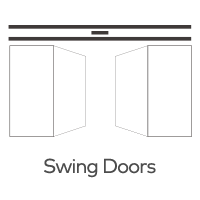What are the key components of an automatic sliding door controller system?
Automatic sliding doors have become a ubiquitous feature in various settings, from shopping malls to airports, due to their convenience and space-saving nature. Behind the seamless operation of these doors lies a sophisticated controller system that orchestrates their movement. This article delves into the essential components that constitute an automatic sliding door controller system, highlighting their roles in ensuring smooth and safe door operation.

1. Motion Sensors
Motion sensors are a critical component of an automatic sliding door controller system. These sensors detect the presence of individuals approaching or standing in front of the door. They play a pivotal role in initiating the door-opening sequence and preventing the door from closing on someone.
2. Activation Mechanisms
Activation mechanisms are devices that users interact with to signal the door to open. Common activation mechanisms include push buttons, touchless sensors, and pressure-sensitive mats. When triggered, these mechanisms send signals to the controller, prompting the door to open.
3. Controller Unit
The controller unit serves as the brain of the automatic sliding door system. It receives signals from motion sensors and activation mechanisms, processes the data, and commands the door to open or close accordingly. Modern controller units are equipped with microprocessors that allow for precise control and customization of door operation parameters.
4. Motor and Drive System
The motor and drive system are responsible for physically moving the sliding door panels. The motor is connected to the door's drive system, which consists of belts, pulleys, and gears. The controller unit sends signals to the motor, instructing it to open or close the door at a specific speed and distance.
5. Safety Sensors
Safety sensors are crucial for preventing accidents and ensuring user safety. These sensors are placed along the edges of the door panels and detect any obstructions in the door's path. If an obstruction is detected, the sensors send signals to the controller to halt the door's movement and reverse its direction.
6. Control Panel
The control panel provides an interface for users and technicians to configure and monitor the automatic sliding door system. It allows for adjustments to parameters such as opening and closing speeds, sensor sensitivity, and other operational settings.
7. Emergency Exit Devices
In the event of a power outage or other emergencies, automatic sliding doors must provide a way for people to exit the premises manually. Emergency exit devices, often in the form of push bars or buttons, disengage the automatic control and allow individuals to push the door open.
8. Battery Backup System
Some advanced automatic sliding door systems incorporate battery backup systems. These ensure that the doors can continue operating for a limited time during power outages, allowing for uninterrupted functionality and egress.
Conclusion
The seamless operation of automatic sliding doors is made possible by a sophisticated controller system composed of various essential components. From motion sensors and activation mechanisms to the controller unit, motor and drive system, safety sensors, control panel, emergency exit devices, and battery backup systems, each component plays a crucial role in ensuring the convenience, safety, and reliability of automatic sliding doors in a wide range of environments. Understanding these components provides insight into the intricate technology that underpins the functionality of these modern door systems.







